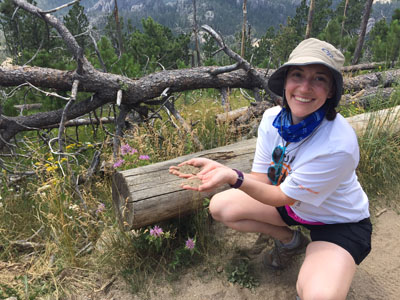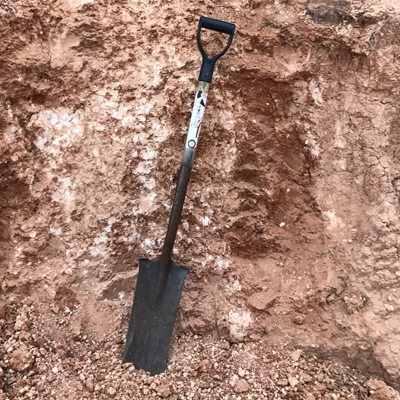As the summer–and summer vacation season–is in full gear, I wonder if you’ve ever wondered about why soils look and feel different in different places. If not, read on and perhaps you’ll be inclined to pay more attention on your next adventure, or even just your next trip outside.

The color and texture of a soil (and many other properties that relate to soil’s ability to produce food) are intertwined with that specific location. Soil scientists group the reasons why soil varies from location to location into five categories. A previous Soils Matter post reviewed ClORPT, but I’ll review a few things here.
The first factor is climate. Differences in a region’s temperature and rainfall can make a huge difference on soils. For example, soils are more likely to be stripped of nutrients and minerals in warmer and wetter climates, where “weathering” processes more rapidly change soil’s physical and chemical composition.
The second factor is the organisms–the plants and animals–that live in a region. Soils that form underneath forests tend to be have fewer nutrients than those that formed under prairie or grassland vegetation. Trees have a long lifespan; prairie grasses die annually. Their decaying roots provide a constant food source for insects and microorganisms living in the soil. This high turnover of nutrients is added to the soil, making prairie and grassland soils fertile and productive. It’s no wonder that the Great Plains states, that were originally prairie, are some of the United States most productive farmland.
The parent material of the soil is another reason for the differences in soils that you see from place to place. Most of the parent material for soil is rocks, but can also be transported minerals from wind and water erosion.
For example, soils located near river bottoms are more likely to have deposited sandy materials from upstream. Soils near volcanoes are known to be rich in minerals because of the erosion of volcanic ash.

Parent materials have important bearing on the color of a soil as well. Soils whose rock parent material is limestone are lighter in color. If a rock has a high iron content, those soils might be more red – such as in North Carolina.
The “relief” or topography of a region also impacts the soil. Soils at the bottom of a hill are more likely to have more “layers” because of continued deposition of materials from higher ground. And higher ground is often said to be “shallower” because of downward material movement.
The final soil forming factor is time. Believe it or not, soils can be considered “young” or “old”, on geologic timescales, and scientists use clues1,2 to uncover these ages. In the northern parts of the United States, soil formation did not officially “begin” until glaciers started melting approximately 18,000 years ago. Volcanic eruptions in an area can lead to relatively “younger” soils, as well.
Atlantic County, New Jersey, where I grew up, historically was predominated by forests, bordering the Atlantic Ocean. Looking at some Natural Resources Conservation Service (NRCS) information,3 I found out that 15% of the county’s soils are tidal marsh, regions close to bodies of water that regularly flood, and much of the rest of the soils are sandy. When I moved to Iowa for graduate school, I found predominantly darker colored soils, indicative of a relatively higher organic matter content, which contributes to the soil’s fertility and productivity.
Soils within a state can vary, too. The soils of western Washington state have a different climate than eastern Washington. Western Washington has frequent rains; eastern Washington has much less rainfall. Western Washington has a quite varied relief, with mountains and even a volcano. Eastern Washington is much more flat. So, it’s no wonder that the soils in those regions are different as well.
All these factors taken together are why I like to describe soil as the living crust of the earth, or the interface of biology, climate, geology and time. So, next time you travel state to state, be sure to pay closer attention to the soil under your feet.
Answered by Andrea Basche, University of Nebraska
To receive notices about future blogs, be sure to subscribe to Soils Matter by clicking on the Follow button on the upper right! Explore more on our webpage About Soils. There you will find more information about Soil Basics, Community Gardens, Green Infrastructure, Green Roofs, Soil Contaminants, materials for Teachers and more.
- https://soilsmatter.wordpress.com/2014/05/14/how-can-some-soil-be-older-than-other-soil/
- https://soilsmatter.wordpress.com/2014/12/01/how-is-the-age-of-soil-figured/
- https://www.nrcs.usda.gov/wps/portal/nrcs/soilsurvey/soils/survey/state/
Are you interested in your state soil? Visit http://www.soils4teachers.org/state-soils to download a free copy of your state soil booklet, prepared by SSSA’s K12 committee.

Wow! You did get to see a wide range of soils from Atlantic County, NJ to Iowa! Did you ever see the different colors of sediment when farmers plowed their fields? I did on Galloway and Downer loamy sands in Ocean County. Could see several colors in one field.